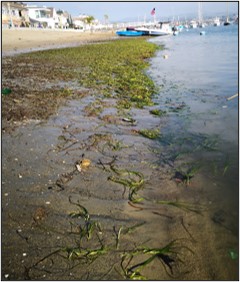First regional survey underway to examine health of Southern California eelgrass beds

SCCWRP and its partners have launched a two-year pilot effort to assess the health of Southern California’s coastal eelgrass beds using a new, bioassessment-based monitoring approach that focuses on evaluating ecological functioning.
The Regional Eelgrass Survey of Condition and Quality (RESCQ), launched in March, represents an important step forward in how Southern California coastal managers track the health of these ecologically important but vulnerable habitats.
Instead of primarily documenting the locations and size of eelgrass beds – as has been historically done – the bioassessment-based monitoring approach will enable researchers to quantitatively assess bed health based upon their ability to provide refugia to fish and other animals, as well as other ecosystem services, including attenuating ocean waves and sequestering carbon.
The pilot monitoring survey marks the first regional assessment of eelgrass beds using a newly developed scientific framework for assessing submerged aquatic vegetation (SAV) habitats; the framework was co-developed by SCCWRP in 2020.
The framework will enable managers to quantitatively assess the success of eelgrass restoration and mitigation projects, including for compliance with California’s eelgrass protection policy.
The framework also can help managers determine if coastal estuaries have achieved beneficial-use designations that are required under stormwater permitting and other regulatory programs.
Eventually, the framework could be adopted and incorporated into routine seagrass monitoring programs, including California’s estuarine Marine Protected Areas (MPA) program.
Eelgrass beds, which are scattered across shallow, soft-bottom coastal areas of Southern California, are the dominant type of seagrass found in California’s coastal embayments. California has invested significant resources into restoring and protecting these fragile ecosystems.
The bioassessment-based monitoring design is the realization of the third of three tiers of the SAV habitat assessment framework. The first and second tiers focus on quantifying the extent and health, respectively, of eelgrass beds relative to what they would be in the absence of human activities. The first tier is currently in development; the second tier, which has not yet been developed, will likely move forward once the third tier is completed.
Researchers will start the bioassessment-based monitoring survey by creating comprehensive maps of all eelgrass beds across Southern California’s estuaries and embayments, using both existing maps and field surveys. Then, SCUBA diver teams will collect a suite of monitoring data at these sites, focusing on the eelgrass bed’s ability to provide habitat for fish and crustaceans.
Researchers’ goal is to build long-term capacity within the State Water Board, Regional Boards and other management agencies for conducting routine, bioassessment-based monitoring of eelgrass beds – initially in Southern California, and eventually statewide.
A management advisory committee is helping to guide the monitoring survey’s design and implementation, including development of a web-based interface to provide access to the monitoring data, including via data visualization tools, and the ability to submit future data sets.
For more information, contact Dr. David Gillett.
More news related to: Bioassessment, Regional Monitoring, Top News